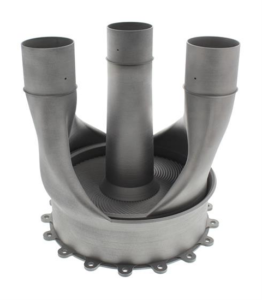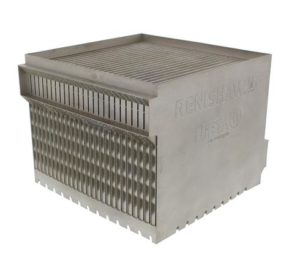HiETA Uses Renishaw Metal 3D Printer to Take Heat Exchangers From Prototyping to Commercial Production
 UK metrology company Renishaw often works in metal 3D printing, and has a goal of making the technology more accessible and mainstream. Its RenAM 500M, a laser powder bed fusion system, was specifically designed for factory floor production of metal components, such as the specialist range of heat exchangers by HiETA Technologies, which uses additive manufacturing to realize energy efficiency and performance.
UK metrology company Renishaw often works in metal 3D printing, and has a goal of making the technology more accessible and mainstream. Its RenAM 500M, a laser powder bed fusion system, was specifically designed for factory floor production of metal components, such as the specialist range of heat exchangers by HiETA Technologies, which uses additive manufacturing to realize energy efficiency and performance.
 Founded in 2011 and boasting facilities that cover the entire AM product development process, HiETA develops metal AM methods to produce lightweight, complex structures for heat-management applications, such as internal combustion engine components, turbo machinery, recuperators, and heat exchangers for fuel cells. The company, which has registered some patents for 3D printed heat exchangers, has worked with Renishaw on multiple occasions, most recently on a microturbine range extender for an electric car.
Founded in 2011 and boasting facilities that cover the entire AM product development process, HiETA develops metal AM methods to produce lightweight, complex structures for heat-management applications, such as internal combustion engine components, turbo machinery, recuperators, and heat exchangers for fuel cells. The company, which has registered some patents for 3D printed heat exchangers, has worked with Renishaw on multiple occasions, most recently on a microturbine range extender for an electric car.
Now, Renishaw’s technology is being used to help HiETA move from the prototyping phase to commercial production of its metal 3D printed heat exchangers.
“With almost all of our projects, we are trying to light-weight components and solve thermal management issues. Through our partnership with Renishaw, we have produced components that are typically around 40% lighter and smaller by volume than anything equivalent that is available on the market,” Stephen Mellor, the Lead Project Engineer at HiETA Technologies, said. “This is possible because, with the Renishaw technology, we can design and manufacture many novel and high performing surfaces integrated into a single component. This would be very difficult to do with conventional methods.”
 Heat exchange products are typically made from thin sheets of material which have been welded together. Production is difficult and time-consuming, due to the complex design, and the welding material makes the part heavier.
Heat exchange products are typically made from thin sheets of material which have been welded together. Production is difficult and time-consuming, due to the complex design, and the welding material makes the part heavier.
There has been some research on using 3D printing to manufacture heat exchangers, and HiETA wanted to confirm that the technology would be able to create the required thin walls, and then make a complete component. In addition, the company wanted to use the experience and knowledge it gained through the project to, as Renishaw put it, “move the process from the manufacture of samples and prototypes into low-volume production.”
Using Renishaw’s AM250 system, the two worked to produce the data, and develop parameter sets, to successfully 3D print thin, leak-free walls out of Inconel, down to 150 micron thicknesses. They produced samples, using a variety of settings on the AM250, at Renishaw’s facility in Stone, as well as at HiETA’s Bristol and Bath Science Park headquarters; the samples were later heat treated and characterized. The companies were able to confirm machine parameters for thin-walled structures through these samples, which HiETA included in its design guidebook for heat transfer in heat exchangers 3D printed with laser powder bed fusion. Once they’d developed the leak-free integral wall, HiETA and Renishaw moved on to a completed, full-size unit, which could be built “in a reasonable build time.”
Together with UK-based vehicle integrator Delta Motorsports, the two companies participated in two separate building projects, the first of which was a cuboid heat exchanger (recuperator) that could be used as an electric vehicle range extender. The second project, a recuperator of annular form, had a goal of taking the component design to even more complex shapes than the traditional cuboid, as that can help lower costs, increase cycle efficiency and product performance, and offer packaging benefits. The annular recuperator, which is a more compact system thanks to its integrated manifolds, can actually wrap around other components.
The first successful 3D printed component was built in 17 days, which HiETA and Renishaw worked to bring down to eighty hours by optimizing the process parameters, and improving both the software and hardware. According to tests, the component, which achieved 30% lower weight and volume, met the requirements for heat transfer and pressure drop.
HiETA, in addition to optimizing Renishaw’s equipment to handle larger samples, used the projects to create a process for extracting excess powder material from the heat exchanger cores, and the projects’ resulting fluid flow and thermal transfer data have also been incorporated in HiETA’s computational fluid dynamics (CFD) and finite-element analysis (FEA) programs, which are used to assess the potential performance of new component designs. Renishaw, in turn, added software improvements to create part build instructions, and to “facilitate processing of the large amounts of data when the complete recuperator is sliced into thin layers.”
Due to its success with Renishaw’s AM250, HiETA has invested in a powerful RenAM 500M system, which will allow the company to cost-effectively produce low volumes of commercial components.
Mellor said, “We are now producing parts for engines with real commercial applications and for customers with very demanding requirements. We use Renishaw’s AM technology to produce very complex parts that give high performance at competitive prices.”
Let us know your thoughts on this and other 3D printing topics at 3DPrintBoard.com or share in the Facebook comments below.
[Source/Images: Renishaw]
Subscribe to Our Email Newsletter
Stay up-to-date on all the latest news from the 3D printing industry and receive information and offers from third party vendors.
You May Also Like
Profiling a Construction 3D Printing Pioneer: US Army Corps of Engineers’ Megan Kreiger
The world of construction 3D printing is still so new that the true experts can probably be counted on two hands. Among them is Megan Kreiger, Portfolio Manager of Additive...
US Army Corps of Engineers Taps Lincoln Electric & Eaton for Largest 3D Printed US Civil Works Part
The Soo Locks sit on the US-Canadian border, enabling maritime travel between Lake Superior and Lake Huron, from which ships can reach the rest of the Great Lakes. Crafts carrying...
Construction 3D Printing CEO Reflects on Being Female in Construction
Natalie Wadley, CEO of ChangeMaker3D, could hear the words of her daughter sitting next to her resounding in her head. “Mum, MUM, you’ve won!” Wadley had just won the prestigious...
1Print to Commercialize 3D Printed Coastal Resilience Solutions
1Print, a company that specializes in deploying additive construction (AC) for infrastructure projects, has entered an agreement with the University of Miami (UM) to accelerate commercialization of the SEAHIVE shoreline...
































